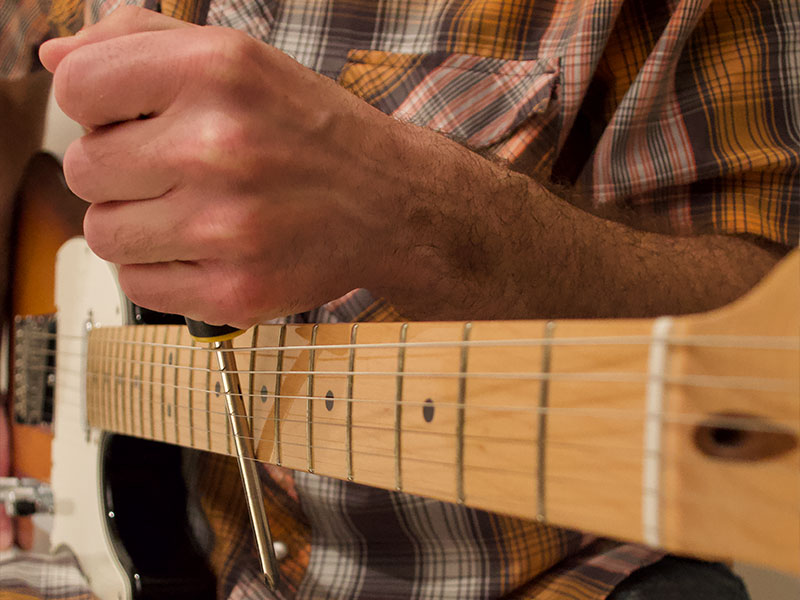
Share Album:
Music for Guitar and Electronics
Mike Frengel composer, guitar
Ravello Records proudly presents MUSIC FOR GUITAR AND ELECTRONICS, an album of original works for guitar from composer Mike Frengel. The collection spans 20 years of Frengel’s creative output and features unconventional guitar tunings, instrumental preparations, and virtuosic performances.
Even for a genre that famously balks at convention, MUSIC FOR GUITAR AND ELECTRONICS is an exciting departure from what we’re used to in the electronic music world. Upon hearing the new album, it comes as no surprise to learn that Frengel is something of an expert in this field. His book The Unorthodox Guitar: A Guide to Alternative Performance Practice, published by Oxford University Press in 2017, reflects his fascination with the guitar and his obsessive quest to engineer new ways of playing it. Hotbird, the first track on the album, utilizes a “prepared” guitar which emits rattling harmonies and alien harmonics. This piece and those that follow highlight Frengel’s desire to wed live recorded performances with electronic manipulation, pushing the guitar to sound and behave like nothing we have ever heard before.
Later, the three-movement work Country Roads incorporates sounds from country western, like the tone bends of a pedal steel and double stops. But this is no Randy Travis tune—amid the ambient sounds of a barnyard, we hear the twanging notes dip and rise like gunshots, eschewing traditional tonality for a host of timbral fascinations. Later, the second movement incorporates Travis picking, with a third movement that includes the sound of an electric guitar bowed with a drumstick.
Electronic music composers are often considered to be on the creative forefront, the true avant-garde. If this is so, Frengel is out at the bleeding edge, taking an instrument we all thought we knew and reimaging its potential. Composers in this genre often pride themselves on deconstructing commonplace instruments and sounds, and Mike Frengel has done just that—the result is like nothing you’ve heard before. It might just cause you to take your old Stratocaster out of its case and give it a strum with a fresh set of ears.
Listen
Stream/Buy
Choose your platform
Track Listing & Credits
| # | Title | Composer | Performer | |
|---|---|---|---|---|
| 01 | Hotbird | Mike Frengel | Mike Frengel, prepared electric guitar & electronics | 10:02 |
| 02 | Slinky | Mike Frengel | Mike Frengel, steel-string acoustic guitar & electronics | 12:45 |
| 03 | Country Roads: I. The Bottle Let Me Bend | Mike Frengel | Mike Frengel, electric guitar & electronics | 4:11 |
| 04 | Country Roads: II. Travis Country | Mike Frengel | Mike Frengel, electric guitar & electronics | 3:52 |
| 05 | Country Roads: III. Lone Star | Mike Frengel | Mike Frengel, electric guitar & electronics | 3:58 |
| 06 | Fireflies | Mike Frengel | Mike Frengel, third-bridge acoustic guitar & electronics | 9:16 |
| 07 | And Then, Romina... | Mike Frengel | Mike Frengel, prepared electric guitar & electronics | 11:57 |
All tracks were recorded at Boom Audio Technologies in Boston MA
Recording & Mixing by Mike Frengel
Photography by Mike Frengel
Executive Producer Bob Lord
Executive A&R Sam Renshaw
A&R Director Brandon MacNeil
A&R Quinton Blue
VP, Audio Production Jeff LeRoy
Audio Director Lucas Paquette
Mastering Shaun Michaud
VP, Design & Marketing Brett Picknell
Art Director Ryan Harrison
Design Edward A. Fleming
Publicity Patrick Niland, Sara Warner
Artist Information

Mike Frengel
Mike Frengel is an internationally recognized composer, performer, researcher, and educator. Born in Mountain View, California, Mike graduated with a B.A. in electroacoustic music from San Jose State University in 1995, where he studied composition and sound production with Allen Strange and Dan Wyman. He spent another three years in the San Francisco Bay Area working at Apple Computers Inc. as well as remaining affiliated with the C.R.E.A.M. Studios at SJSU as a Research Scientist. Mike completed his M.A. in electroacoustic music composition at the Bregman Studios at Dartmouth College in 1999 under the tutelage of Jon Appleton, Charles Dodge, Larry Polansky, and Christian Wolff. He completed his Ph.D. at City University, London, where he studied composition with Denis Smalley.
Notes
This collection of works for guitar and electronics was composed over a period of 20 years, beginning with And Then, Romina… in 2000. The pieces approach the guitar in unconventional ways, incorporating alternative tunings, instrumental preparations, extended performance techniques, and electronic augmentations. Such adventurism is largely motivated by a desire to find a coherent musical language that both the live instrument and the electronically mediated sounds can flourish in—a musical language that allows both live and non-live elements to bring their full potential to the work. While conventional musical materials most certainly allow a musician to bring the skills developed over years of study to the performance, to confine non-live elements to the timbres and behaviors typically associated with the instrument would greatly restrict the electronic components and, in many ways, undermine my very interest in them. This quest for a common ground between live and non-live elements in mixed works has led me to push the guitar beyond familiar timbral and behavior expectations and closer to characteristics of electroacoustic music. It is in this spirit that I composed this music.
My experience working with the guitar in unconventional ways motivated me to write a book on the subject, The Unorthodox Guitar: A Guide to Alternative Performance Practice, published by Oxford University Press in 2017. In return, the book, and the research that led to it, has inspired my later compositions and the way I think about the guitar. Having performed these works at festivals, conferences, and other venues for years, I am delighted to publicly release them in a single collection. I hope you enjoy them. For more information, including scores and performance materials, visit www.mikefrengel.com.



